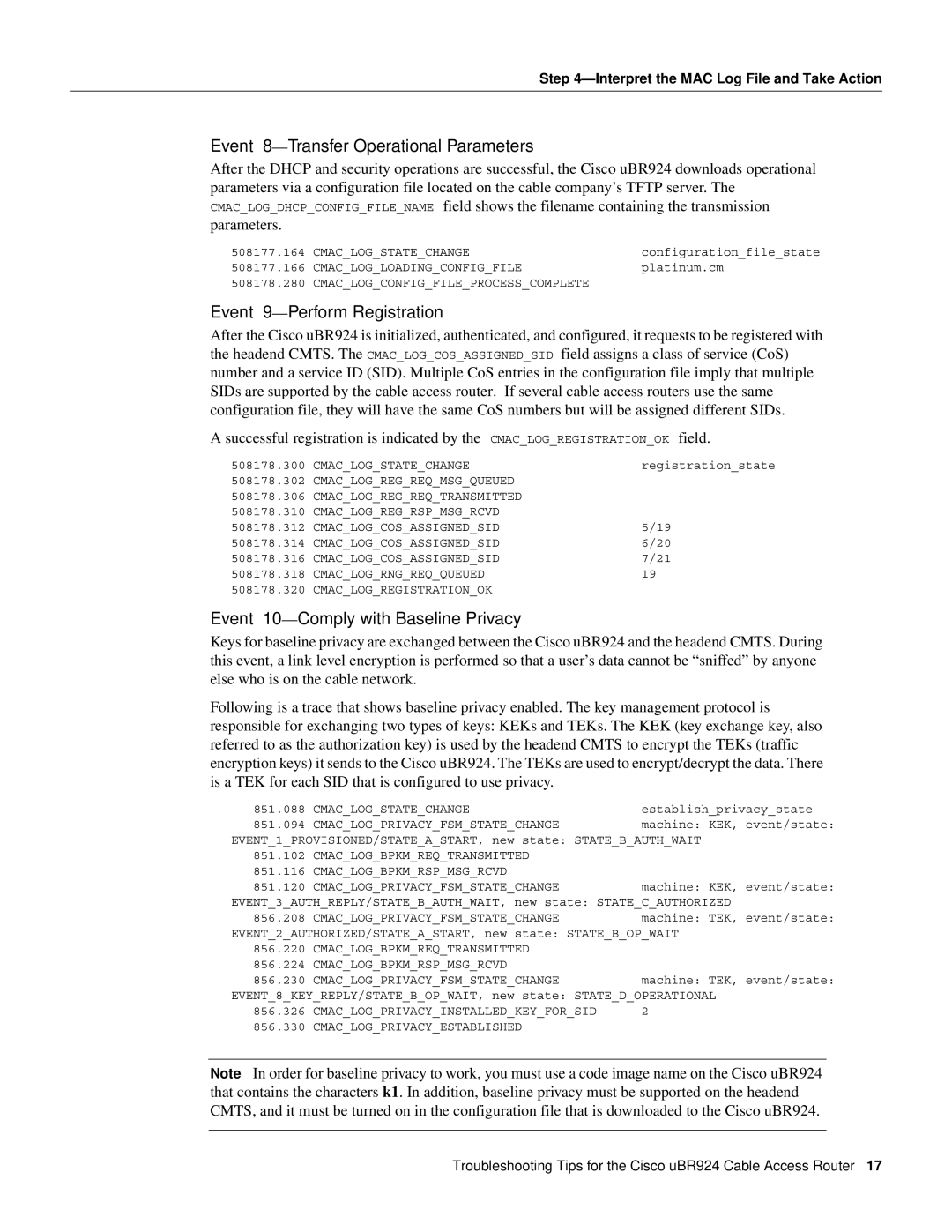
A successful registration is indicated by the CMAC_LOG_REGISTRATION_OK field.
508178.300 | CMAC_LOG_STATE_CHANGE | registration_state |
508178.302 | CMAC_LOG_REG_REQ_MSG_QUEUED |
|
508178.306 | CMAC_LOG_REG_REQ_TRANSMITTED |
|
508178.310 | CMAC_LOG_REG_RSP_MSG_RCVD |
|
508178.312 | CMAC_LOG_COS_ASSIGNED_SID | 5/19 |
508178.314 | CMAC_LOG_COS_ASSIGNED_SID | 6/20 |
508178.316 | CMAC_LOG_COS_ASSIGNED_SID | 7/21 |
508178.318 | CMAC_LOG_RNG_REQ_QUEUED | 19 |
508178.320 | CMAC_LOG_REGISTRATION_OK |
|
Event 10—Comply with Baseline Privacy
Keys for baseline privacy are exchanged between the Cisco uBR924 and the headend CMTS. During this event, a link level encryption is performed so that a user’s data cannot be “sniffed” by anyone else who is on the cable network.
Following is a trace that shows baseline privacy enabled. The key management protocol is responsible for exchanging two types of keys: KEKs and TEKs. The KEK (key exchange key, also referred to as the authorization key) is used by the headend CMTS to encrypt the TEKs (traffic encryption keys) it sends to the Cisco uBR924. The TEKs are used to encrypt/decrypt the data. There is a TEK for each SID that is configured to use privacy.
851.088 | CMAC_LOG_STATE_CHANGE | establish_privacy_state |
851.094 | CMAC_LOG_PRIVACY_FSM_STATE_CHANGE | machine: KEK, event/state: |
EVENT_1_PROVISIONED/STATE_A_START, new state: STATE_B_AUTH_WAIT | ||
851.102 | CMAC_LOG_BPKM_REQ_TRANSMITTED |
|
851.116 | CMAC_LOG_BPKM_RSP_MSG_RCVD |
|
851.120 | CMAC_LOG_PRIVACY_FSM_STATE_CHANGE | machine: KEK, event/state: |
EVENT_3_AUTH_REPLY/STATE_B_AUTH_WAIT, new state: STATE_C_AUTHORIZED | ||
856.208 | CMAC_LOG_PRIVACY_FSM_STATE_CHANGE | machine: TEK, event/state: |
EVENT_2_AUTHORIZED/STATE_A_START, new state: STATE_B_OP_WAIT | ||
856.220 | CMAC_LOG_BPKM_REQ_TRANSMITTED |
|
856.224 | CMAC_LOG_BPKM_RSP_MSG_RCVD |
|
856.230 | CMAC_LOG_PRIVACY_FSM_STATE_CHANGE | machine: TEK, event/state: |
EVENT_8_KEY_REPLY/STATE_B_OP_WAIT, new state: STATE_D_OPERATIONAL | ||
856.326 | CMAC_LOG_PRIVACY_INSTALLED_KEY_FOR_SID | 2 |
856.330 | CMAC_LOG_PRIVACY_ESTABLISHED |
|
Note In order for baseline privacy to work, you must use a code image name on the Cisco uBR924 that contains the characters k1. In addition, baseline privacy must be supported on the headend CMTS, and it must be turned on in the configuration file that is downloaded to the Cisco uBR924.
Troubleshooting Tips for the Cisco uBR924 Cable Access Router 17
